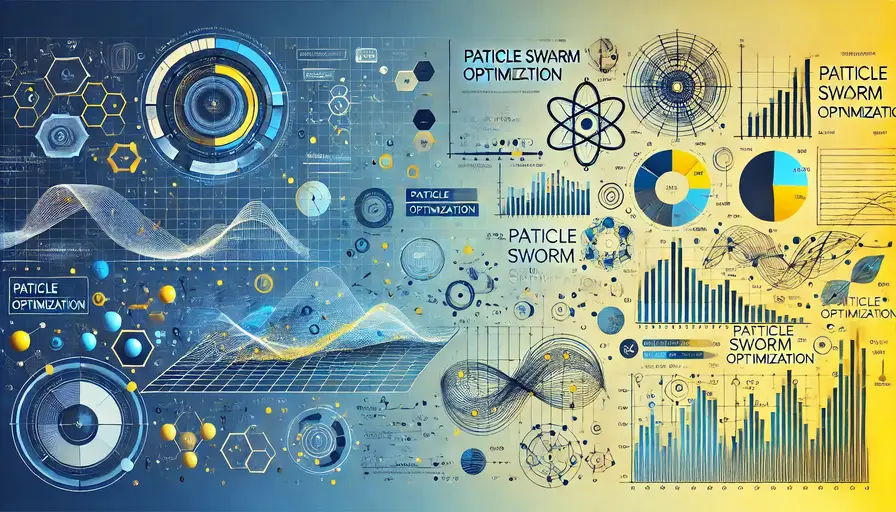
Particle Swarm Optimization

Particle Swarm Optimization (PSO) is a powerful computational method used for optimization problems, inspired by the social behavior of birds and fish. It is widely used in various fields due to its simplicity and effectiveness. In this comprehensive guide, we will explore the fundamentals of PSO, its application, and how to implement it effectively.
Fundamentals of Particle Swarm Optimization
Origins and Inspiration
The Particle Swarm Optimization algorithm was developed in the 1990s, drawing inspiration from the social dynamics observed in flocks of birds and schools of fish. This biological inspiration leads to a swarm intelligence approach where each particle adjusts its trajectory based on personal and collective experiences. The mechanism of PSO involves particles (potential solutions) flying through the solution space, adjusting their positions according to their own experience and that of neighboring particles.
Algorithm Mechanics
The PSO algorithm initializes with a group of random particles and then searches for optima by updating generations. Each particle is treated as a point in a multidimensional space that adjusts its position based on its own experience and the experience of its neighbors. The velocity of each particle is influenced by three components: its previous velocity, the distance from its best-known position, and the distance from the swarm’s best-known position.
Mathematical Representation
The mathematical model of PSO involves two key equations: one for velocity update and one for position update. These equations incorporate the concepts of inertia, personal influence, and social influence. The velocity update equation is given by:
 What is Long Short-Term Memory?
What is Long Short-Term Memory?$$
v_i(t+1) = w \cdot v_i(t) + c_1 \cdot r_1 \cdot (p_i(t) - x_i(t)) + c_2 \cdot r_2 \cdot (g(t) - x_i(t))
$$
where \(v_i\) is the velocity, \(x_i\) is the position, \(p_i\) is the best-known position of the particle, and \(g\) is the best-known position of the swarm. The position update equation is:
$$ x_i(t+1) = x_i(t) + v_i(t+1)$$
Applications of Particle Swarm Optimization
Engineering and Design
PSO is extensively used in engineering for optimizing designs and processes. For instance, it is applied in aerospace engineering for optimizing the design of aircraft wings to achieve maximum aerodynamic efficiency. Similarly, in civil engineering, PSO helps in optimizing the design of structures to ensure stability and cost-effectiveness.
 Choosing the Right ML Classification Algorithm: Decision Tree
Choosing the Right ML Classification Algorithm: Decision TreeMachine Learning and Data Mining
In machine learning, PSO is used to optimize the hyperparameters of algorithms such as neural networks, SVMs, and decision trees. It helps in improving the accuracy and performance of these models. Additionally, in data mining, PSO is employed to optimize the selection of features, which leads to better model performance and reduced computational complexity.
Economic and Financial Modeling
PSO is valuable in the field of finance for portfolio optimization, where it helps in maximizing returns while minimizing risk. In economic modeling, PSO is used to optimize parameters in complex economic models, aiding in better predictions and decision-making processes.
Implementing Particle Swarm Optimization
Basic Implementation
To implement PSO, one must initialize a population of particles with random positions and velocities. Each particle’s position and velocity are updated iteratively based on the aforementioned equations. Below is a basic example of PSO implemented in Python:
import numpy as np
# Define the objective function
def objective_function(x):
return x[0]**2 + x[1]**2
# Initialize parameters
num_particles = 30
num_dimensions = 2
max_iter = 100
w = 0.5
c1 = 1.5
c2 = 1.5
# Initialize particles
particles = np.random.rand(num_particles, num_dimensions)
velocities = np.random.rand(num_particles, num_dimensions)
personal_best_positions = particles.copy()
global_best_position = personal_best_positions[np.argmin([objective_function(p) for p in personal_best_positions])]
# PSO loop
for i in range(max_iter):
for j in range(num_particles):
r1, r2 = np.random.rand(2)
velocities[j] = w * velocities[j] + c1 * r1 * (personal_best_positions[j] - particles[j]) + c2 * r2 * (global_best_position - particles[j])
particles[j] += velocities[j]
if objective_function(particles[j]) < objective_function(personal_best_positions[j]):
personal_best_positions[j] = particles[j]
if objective_function(personal_best_positions[j]) < objective_function(global_best_position):
global_best_position = personal_best_positions[j]
print(f'Best Position: {global_best_position}, Best Value: {objective_function(global_best_position)}')Advanced Techniques
Incorporating advanced techniques can significantly enhance the performance of the PSO algorithm. Techniques such as adaptive parameters, where the inertia weight and learning factors ( c1 ) and ( c2 ) change dynamically, can lead to better convergence. Another approach is using constriction factors to control the velocity update, which helps in avoiding excessive exploration.
 Normalization Techniques for Deep Learning Regression Models
Normalization Techniques for Deep Learning Regression ModelsParallel and Distributed PSO
To handle large-scale optimization problems, parallel and distributed PSO techniques are employed. By distributing the computational load across multiple processors or machines, these techniques enhance the scalability and efficiency of the PSO algorithm. Frameworks like Apache Spark and Hadoop facilitate the implementation of distributed PSO.
Comparison with Other Optimization Techniques
Genetic Algorithms
Genetic Algorithms (GA) and PSO are both population-based optimization techniques but differ in their approach. While GA relies on crossover and mutation operators to evolve the population, PSO uses the concept of social behavior and swarm intelligence. PSO often converges faster and requires fewer parameters to adjust compared to GA.
Simulated Annealing
Simulated Annealing (SA) is another optimization technique inspired by the annealing process in metallurgy. It uses a probabilistic approach to escape local optima by accepting worse solutions with a certain probability. Compared to PSO, SA is more suited for problems with discrete search spaces and does not leverage the social dynamics seen in PSO.
Differential Evolution
Differential Evolution (DE) is a technique similar to GA but uses a different strategy for generating new candidate solutions. It relies on the difference between randomly selected pairs of solutions to evolve the population. PSO, in contrast, updates particles based on their velocities and the best-known positions. While both DE and PSO are effective for continuous optimization problems, PSO tends to be more intuitive and easier to implement.
 XGBoost: A Powerful ML Model for Classification and Regression
XGBoost: A Powerful ML Model for Classification and RegressionChallenges and Solutions in Particle Swarm Optimization
Premature Convergence
One of the challenges in PSO is premature convergence, where particles get trapped in local optima early in the search process. This can be mitigated by introducing techniques such as velocity clamping, dynamic adjustment of inertia weight, or hybridizing PSO with other optimization methods like Genetic Algorithms to maintain diversity in the swarm.
Parameter Sensitivity
The performance of PSO is highly sensitive to its parameters: inertia weight (( w )), cognitive coefficient (( c1 )), and social coefficient (( c2 )). Proper tuning of these parameters is crucial for achieving optimal results. Techniques such as adaptive parameter control and parameter tuning using methods like Grid Search or Bayesian Optimization can help in finding the best parameter settings.
High-Dimensional Spaces
In high-dimensional optimization problems, PSO can suffer from dimensionality curse, leading to slow convergence and increased computational complexity. Strategies such as dimension reduction techniques (e.g., Principal Component Analysis) and cooperative co-evolution can help in tackling high-dimensional spaces by breaking down the problem into smaller, more manageable subproblems.
Real-World Examples
Optimizing Neural Networks
PSO is widely used to optimize the architecture and hyperparameters of neural networks. By adjusting parameters such as the number of layers, neurons per layer, learning rate, and batch size, PSO helps in finding configurations that enhance the network's performance. For example, in convolutional neural networks used for image recognition, PSO can optimize filter sizes, stride lengths, and pooling operations to achieve better accuracy.
 Bootstrapping: Training Deep Neural Networks on Noisy Labels
Bootstrapping: Training Deep Neural Networks on Noisy LabelsResource Allocation in Cloud Computing
In cloud computing, PSO is employed to optimize resource allocation, ensuring efficient utilization of resources while minimizing costs and maximizing performance. It helps in tasks like virtual machine placement, load balancing, and energy consumption optimization. Cloud service providers like Amazon Web Services and Microsoft Azure leverage PSO for dynamic and efficient resource management.
Traffic Flow Optimization
PSO is applied in optimizing traffic flow in urban areas to reduce congestion and improve transportation efficiency. By optimizing traffic light timings, route planning, and vehicle dispatch systems, PSO contributes to smoother and more efficient traffic management. Real-time data from sensors and traffic cameras can be integrated with PSO to dynamically adjust traffic control strategies.
Practical Considerations
Implementation Tips
When implementing PSO, it is important to initialize particles within a feasible search space and to use appropriate bounds to prevent particles from exploring irrelevant regions. Additionally, implementing a termination criterion based on a predefined number of iterations or a convergence threshold ensures the algorithm halts at an optimal solution.
Hybrid Approaches
Combining PSO with other optimization techniques, such as Simulated Annealing or Differential Evolution, can yield hybrid algorithms that leverage the strengths of each method. These hybrid approaches often achieve better performance and robustness, especially in complex optimization problems.
 SVM Regression in Machine Learning: Understanding the Basics
SVM Regression in Machine Learning: Understanding the BasicsVisualization and Analysis
Visualizing the optimization process helps in understanding the behavior of the swarm and diagnosing issues like premature convergence. Tools like Matplotlib in Python can be used to plot the trajectories of particles and the convergence curve, providing insights into the algorithm's performance.
import matplotlib.pyplot as plt
# Example visualization of particle trajectories
def plot_trajectories(particles, global_best_position):
plt.figure(figsize=(10, 6))
for particle in particles:
plt.plot(particle[:, 0], particle[:, 1], marker='o')
plt.scatter(global_best_position[0], global_best_position[1], color='red', label='Global Best')
plt.title('Particle Trajectories')
plt.xlabel('X1')
plt.ylabel('X2')
plt.legend()
plt.show()
# Assuming particles is a numpy array with shape (num_particles, num_iterations, num_dimensions)
# and global_best_position is a numpy array with shape (num_dimensions,)
plot_trajectories(particles, global_best_position)Future Directions
Integration with Machine Learning
The integration of PSO with machine learning techniques opens up new avenues for research and application. For example, PSO can be combined with deep learning to optimize neural network architectures and training parameters. Additionally, PSO can be used in reinforcement learning to optimize policies and reward functions.
Quantum Particle Swarm Optimization
Quantum Particle Swarm Optimization (QPSO) is an emerging area that incorporates principles from quantum mechanics into the traditional PSO framework. QPSO introduces concepts such as quantum superposition and entanglement, leading to potentially faster convergence and improved exploration capabilities.
Swarm Robotics
In the field of swarm robotics, PSO is applied to coordinate the actions of multiple robots to achieve collective tasks. This includes applications in search and rescue operations, environmental monitoring, and autonomous exploration. The collective behavior and distributed control mechanisms of PSO make it well-suited for these applications.
Particle Swarm Optimization is a versatile and effective optimization technique with a wide range of applications across various domains. Its ability to leverage social behavior and collective intelligence makes it a powerful tool for solving complex optimization problems. By understanding the fundamentals, addressing challenges, and exploring advanced techniques, practitioners can harness the full potential of PSO in their respective fields.
If you want to read more articles similar to Particle Swarm Optimization, you can visit the Algorithms category.






You Must Read